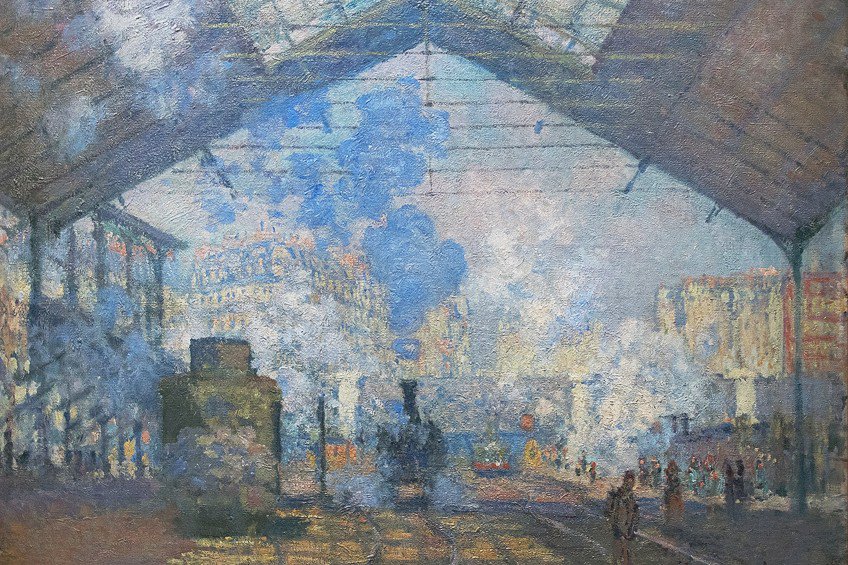“Gare St Lazare” by Claude Monet – Monet’s Train Station Painting
Gare St Lazare by Claude Monet is a famous Impressionist train station painting. In the 19th century, trains were deemed as France’s new cathedrals. Monet was also very inspired by these colossal steam giants that opened up the country to the city. In this article, we will discover what made Claude Monet such an influential modern painter, in what context he created the Gare Saint Lazare painting, and complete a visual analysis of this train station painting to understand Monet’s technical choices.
Artist Abstract: Who Was Claude Monet?
Claude Monet was born in 1840 in the coastal town of Le Havre, France. When Monet was a young boy he already started showing an intuitive talent for art and began to study painting with local artists. He went on to study in Paris, where he was introduced to the works of the Barbizon School and the Realist movement, which would have a profound influence on his own artistic style.
In the 1860s, Monet began to experiment with the style that would come to be known as Impressionism. He focused on capturing the fleeting effects of light and color, often painting outdoors and working quickly to capture the changing atmosphere of the moment.
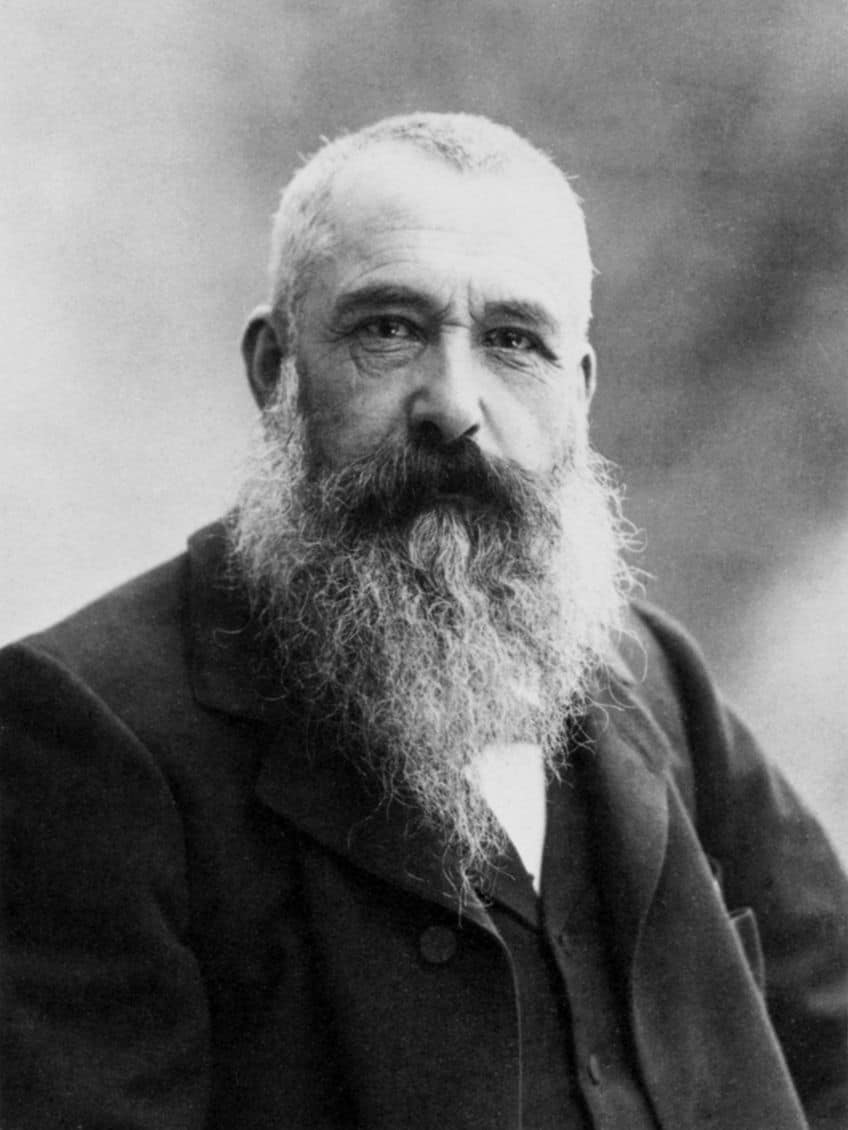
This approach was groundbreaking at the moment in time and was often criticized by the traditional art establishment. Monet’s most famous paintings include the Haystacks (1890-1891) series, in which he depicted stacks of harvested grain at different times of the day, capturing the changing light and shadows. Another famous series is the Water Lilies (1897-1926), in which Monet painted flowers and a pond at his home in Giverny, France. He also painted several series of the Rouen Cathedral, capturing its facade at different times of the day and in different weather conditions.
Monet died in 1926, leaving behind a legacy of innovation and creativity that continues to inspire artists and art lovers today. His innovative approach to capturing light and color and his devotion to capturing the beauty of the natural world have made him one of the most beloved and enduring artists of all time.
Gare Saint Lazare Painting in Context
| Date | 1877 |
| Medium | Oil on canvas |
| Type of Painting | Historical painting |
| Movement | Impressionism |
| Dimensions (cm) | 75 × 100 |
| Location | Musée d’Orsay, Paris, France |
The Gare St. Lazare is one of the most iconic paintings by Claude Monet. It was painted in 1877, at a time when Monet was living in Paris with his wife and children. Let us spend the next section of the article contextualizing this painting in the artist’s personal life, career, and in the French socio-political context, in which it was created.
Monet’s Train Station Paintings In the Context of His Career and Personal Life
By 1877, when Monet created the Gare Saint Lazare painting, he was already a leading figure in the Impressionist movement, which sought to capture the fleeting effects of light and color in the modern world. At the time he painted Gare St. Lazare, Monet was fascinated by the changes brought about by industrialization and the growth of the city. The Gare St. Lazare was a bustling train station in Paris and was a symbol of the rapid pace of modern life.
Monet sought to capture the energy and dynamism of the scene in his painting.
Monet was also working on several other series at the time, including a series of the Rouen Cathedral and the series, Haystacks. In each of these series, Monet was exploring new techniques and pushed the boundaries of art. He was particularly interested in capturing the changing effects of light and color and was experimenting with new ways to capture the atmosphere of the moment. Gare St. Lazare by Claude Monet is an excellent example of the artist’s developing style.
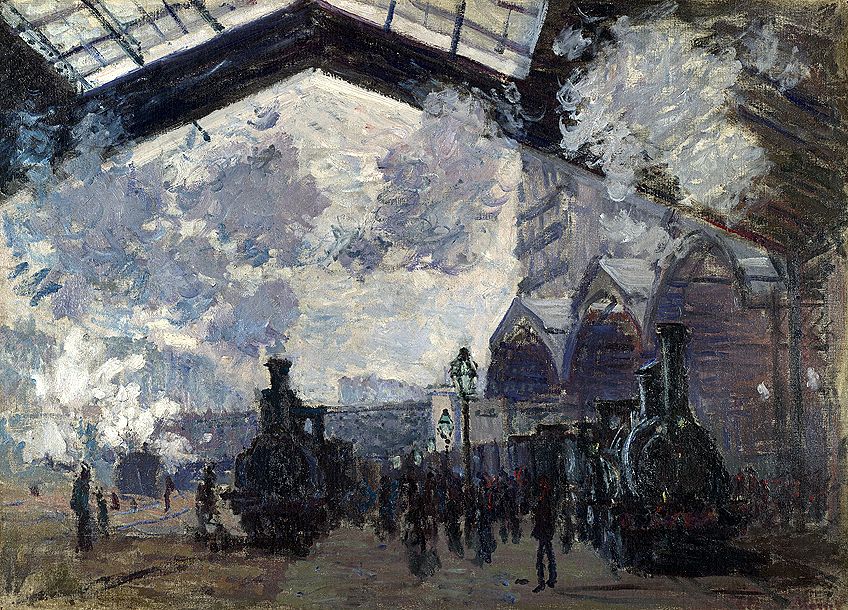
Overall, The Gare Saint Lazare painting is an important painting in Monet’s personal life and professional career. It captures the rapid pace of modern life and the changing landscape of Paris and is an excellent example of Monet’s innovative approach to capturing light and color.
Today, The Gare St. Lazare remains one of Monet’s most iconic paintings and continues to inspire artists and art lovers around the world.
A Brief Western Socio-Historical Overview of Monet’s Train Station Painting
The Impressionists wanted to bring a sense of presence back into society. Many of their paintings are nostalgic for simpler things and highlight the fleeting nature of the moment. Many of Monet’s series of paintings engage a similar thematic expression. The Haystacks, for example, offers a glimpse of the fleeting change of light over a simple country scene.
These moments of stillness in Monet’s paintings came as a breath of fresh air to the Parisian society evolving rapidly with the industrial revolution. For Monet, the Gare St. Lazare train station was an example of the fast pace of technical progress.
It had such an impact on his life and all of Paris. It is where the train brought him out of the countryside and into the city of his artistic ventures to find new inspiration. He rendered this symbol of modern life with the fleeting brushstrokes and unmixed paints of the Impressionist style. Almost as if to say, “look up from this busy train station you pass every day, the light is doing something stunning with the steam.”
A Visual Analysis of Gare St Lazare by Claude Monet
Monet painted eleven final iterations of this buzzing and modern train station, including pencil sketches now collected by the Museé Marmottan in Paris. Stream had an incredible impact on 19th-century painters and Monet’s train station paintings are no different. Motivated by the inspiring visuals of the era of invention, Monet created a series of vibrant paintings that have become synonymous with Impressionism. In this section of the article, we will look at the technical components of the painting, The Gare Saint-Lazare (1877), and what made it different from other Impressionist works of art.
Compositional Overview
There is a famous story, told by painter Pierre-Auguste Renoir (1841 – 1919), about Monet bargaining with the Gare Saint-Lazare’s master to have a few trains staged with steam bellowing out at Monet’s wish. There is no way to know whether this quirky tale is true, however, it illustrates Claude Monet’s commitment to compositions. Unlike other Impressionist artists, Monet altered and staged his painting compositions.
Impressionists at that stage were trying to capture spontaneous moments and the changes of light and color in a specific instant. Monet was interested in the fleeting changes of light, but still incorporated considered structure in his compositions.
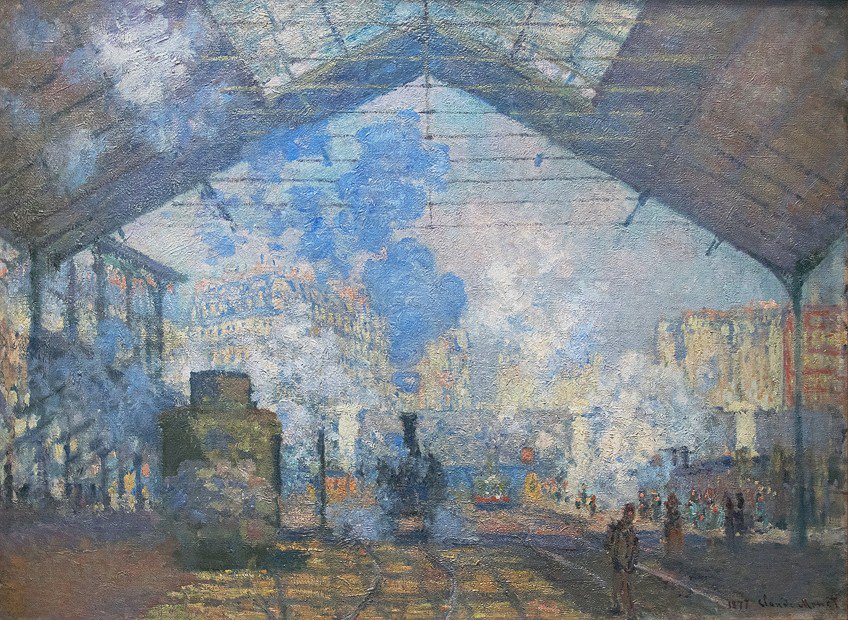
The composition of the painting features a diagonal line created by the train tracks that cut through the center of the canvas, leading the viewer’s eye toward the smoke-filled train platform in the background. The right foreground is dominated by a group of people waiting for their trains, while in the background, a train can be seen pulling into the station. The composition sets up various sightlines and areas of movement. This adds to the vivid and energetic feeling of the painting.
Subject Matter
Subject matter-wise, the painting captures the rapid pace of modern life and the changing landscape of Paris in the late 19th century. Monet was fascinated by the changes brought about by industrialization and the city’s growth, and this painting reflects his interest in capturing the energy and dynamism of modern life. By using Impressionists practices, Monet also makes an artistic statement with The Gare Saint-Lazare. He uses a modern art practice to paint a modern pictorial motif. The blurry and imperfect composition renders the changing nature of everything in the world at that point.
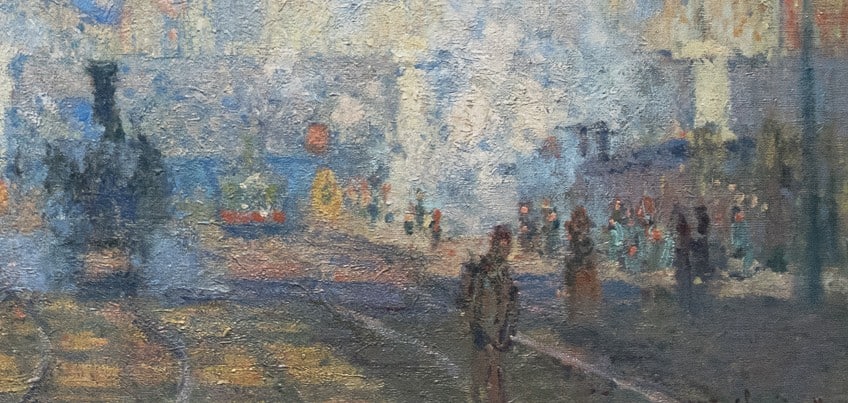
Color and Light
In this painting, Monet uses a muted palette of grays, blues, and greens to create a moody and atmospheric atmosphere. The light source is diffused and hazy, adding to the overall atmosphere of the scene. The smoke from the train engines and the steam clouds provide a dramatic contrast against the cloudy sky and the drab buildings in the background. This use of moody light does not make the painting appear dark.
Monet uses a range of warm tones of yellow, ocher, sienna, and orange to give the painting a balanced and light feeling.
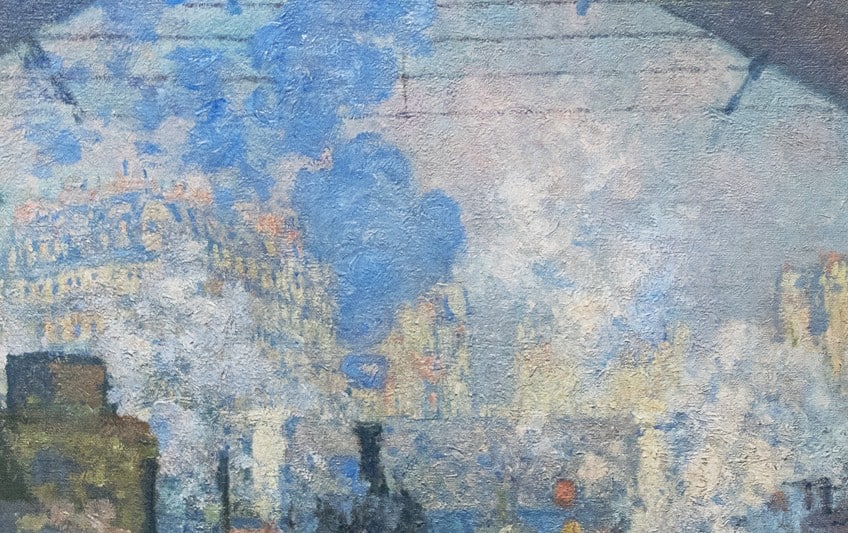
Texture
The texture of the painting is loose and impasto, with thick, visible brushstrokes creating a sense of movement and energy. The thick paint also adds depth to the painting, making the trains and steam clouds appear to be in the foreground while the buildings and people in the background appear more distant.
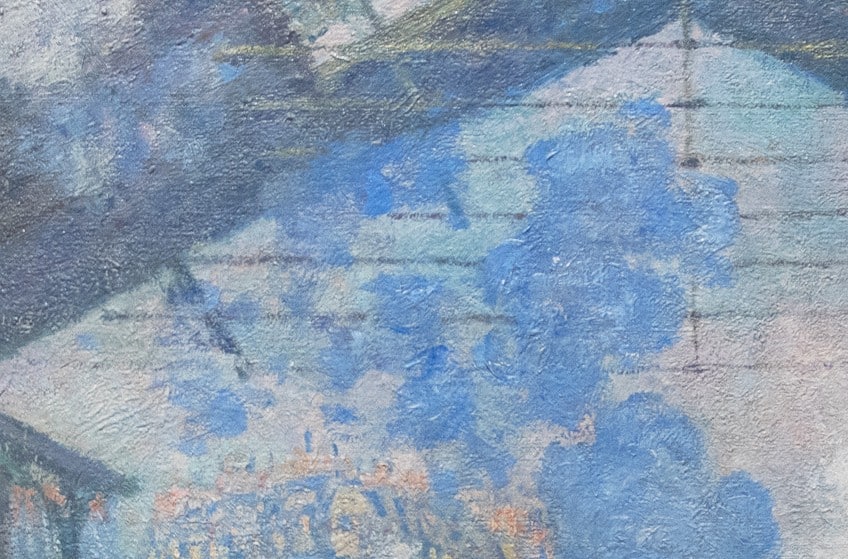
Perspective
The perspective of the painting is slightly elevated as if the viewer is standing on a platform or bridge overlooking the train station. The form of the trains, buildings, and people is loosely defined, adding to the sense of movement and the fleeting nature of modern life.
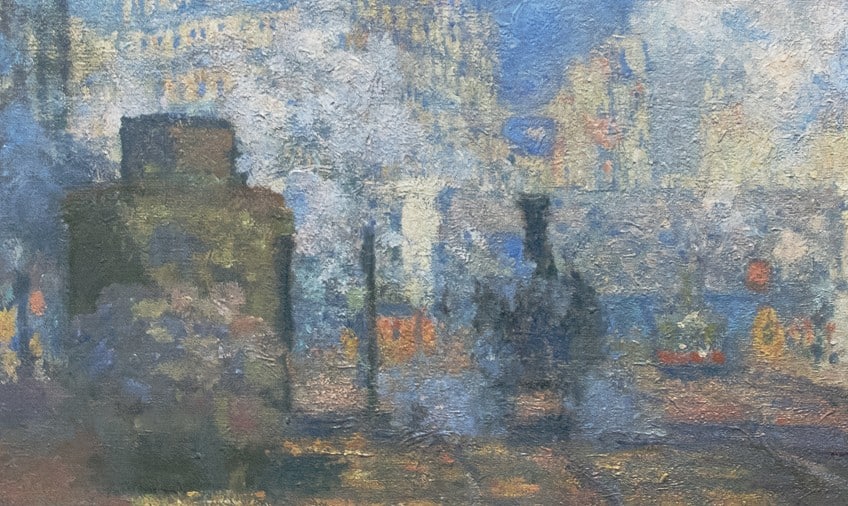
A Comparative Visual Study: Gare St Lazare by Claude Monet and Woman and Girl at Gare-Saint Lazare by Édouard Manet
Claude Monet’s painting The Gare Saint-Lazare (1877) and Édouard Manet’s painting Woman and Girl at Gare-Saint Lazare (1873) are both iconic pieces of art history that capture the essence of 19th-century Paris. While both paintings depict the Gare Saint-Lazare railway station, they differ significantly in style, technique, and subject matter.
In Manet’s painting, Woman and Girl at Gare-Saint Lazare, the central figures are two women dressed in contemporary fashion, waiting for their train. The woman in the foreground looks directly at the viewer, while the younger girl beside her seems lost in thought.
The scene is set against the backdrop of the railway station, with trains and people milling about in the background. The painting’s brushwork is loose and expressive, and Manet uses a monochromatic palette of blacks, grays, and whites to create a somber and atmospheric effect.
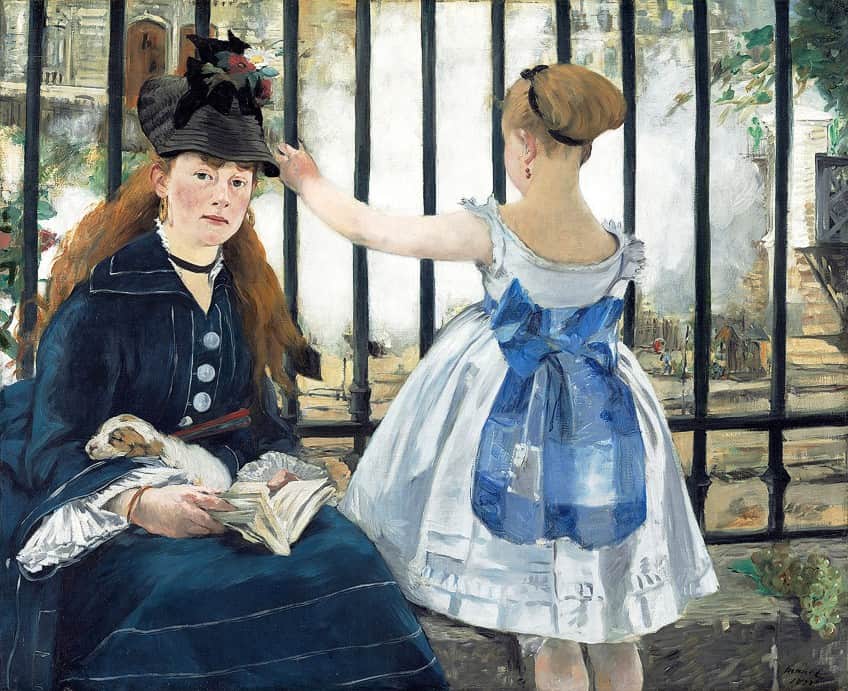
On the other hand, Monet’s The Gare Saint-Lazare painting captures the bustling energy of the railway station. The painting is filled with vibrant colors, and the brushwork is quick and light, giving the impression of a moment caught in motion. Monet’s painting captures the station’s steam, smoke, and noise, and the viewer can almost hear the sound of the trains and the hustle and bustle of the commuters.
Unlike Manet’s painting, Monet’s composition is filled with people and movement, with the railway station serving as a metaphor for modernity.
One striking difference between the two paintings is their treatment of the railway station itself. In Manet’s painting, the railway station serves as a backdrop for the two women, and the focus is on their psychological state. The railway station becomes a symbol of modernity and progress, with the women representing the human experience in the midst of this upheaval. In Monet’s painting, the railway station is the subject, with the focus on the energy and vitality of the modern world.
In conclusion, The Gare St Lazare by Claude Monet is a masterpiece of Impressionism and a reflection of the changing world of 19th-century Paris. Through his use of color, light, and brushwork, Monet captures the energy and movement of the railway station, while also offering a commentary on the modernity and progress of the time. The painting is a prime example of the Impressionist movement, with its emphasis on capturing the fleeting, ephemeral moments of life. Through The Gare Saint-Lazare, Monet created not only a beautiful work of art, but also a time capsule of a world in transition, a testament to the power of art to capture the essence of a moment in time.
Frequently Asked Questions
What Technical Elements Make The Gare Saint-Lazare (1877) So Visually Impressive?
In terms of texture, Monet uses thick, visible brushstrokes to create a sense of movement and energy. The thick paint also adds depth to the painting, making the trains and steam clouds appear to be in the foreground, while the buildings and people in the background appear more distant. In terms of color and light, Monet uses a muted palette of grays, blues, and greens, creating a moody and atmospheric atmosphere. The light source is diffused and hazy, adding to the overall atmosphere of the scene. The smoke from the train engines and the steam clouds provide a dramatic contrast against the cloudy sky and the drab buildings in the background.
What Is the Symbolism of The Gare St Lazare by Claude Monet?
The painting is symbolic of the impact of the Industrial Revolution on Paris and the larger world. The train station represents a hub of commerce and transportation, connecting people and goods across the country and beyond. At the same time, it is a symbol of the changing landscape of Paris and the rapid pace of modern life, which Monet sought to capture in his paintings.
What Made Claude Monet Such an Influential Artist?
Throughout his career, Monet continued to push the boundaries of art and experiment with new techniques. He was one of the leading figures of the Impressionist movement, and his work inspired a new generation of artists to explore the possibilities of modern art. Monet’s influence can be seen in the works of the Post-Impressionist and Fauvist movements that followed, as well as in the works of modern artists around the world.
Nicolene Burger, a South African multimedia artist and creative consultant, specializes in oil painting and performance art. She earned her BA in Visual Arts from Stellenbosch University in 2017. Nicolene’s artistic journey includes exhibitions in South Korea, participation in the 2019 ICA Live Art Workshop, and solo exhibitions. She is currently pursuing a practice-based master’s degree in theater and performance. Nicolene focuses on fostering sustainable creative practices and offers coaching sessions for fellow artists, emphasizing the profound communicative power of art for healing and connection. Nicolene writes blog posts on art history for artfilemagazine with a focus on famous artists and contemporary art.
Learn more about Nicolene Burger and about us.
Cite this Article
Nicolene, Burger, ““Gare St Lazare” by Claude Monet – Monet’s Train Station Painting.” artfilemagazine – Your Online Art Source. April 14, 2023. URL: https://artfilemagazine.com/gare-st-lazare-by-claude-monet/
Burger, N. (2023, 14 April). “Gare St Lazare” by Claude Monet – Monet’s Train Station Painting. artfilemagazine – Your Online Art Source. https://artfilemagazine.com/gare-st-lazare-by-claude-monet/
Burger, Nicolene. ““Gare St Lazare” by Claude Monet – Monet’s Train Station Painting.” artfilemagazine – Your Online Art Source, April 14, 2023. https://artfilemagazine.com/gare-st-lazare-by-claude-monet/.


